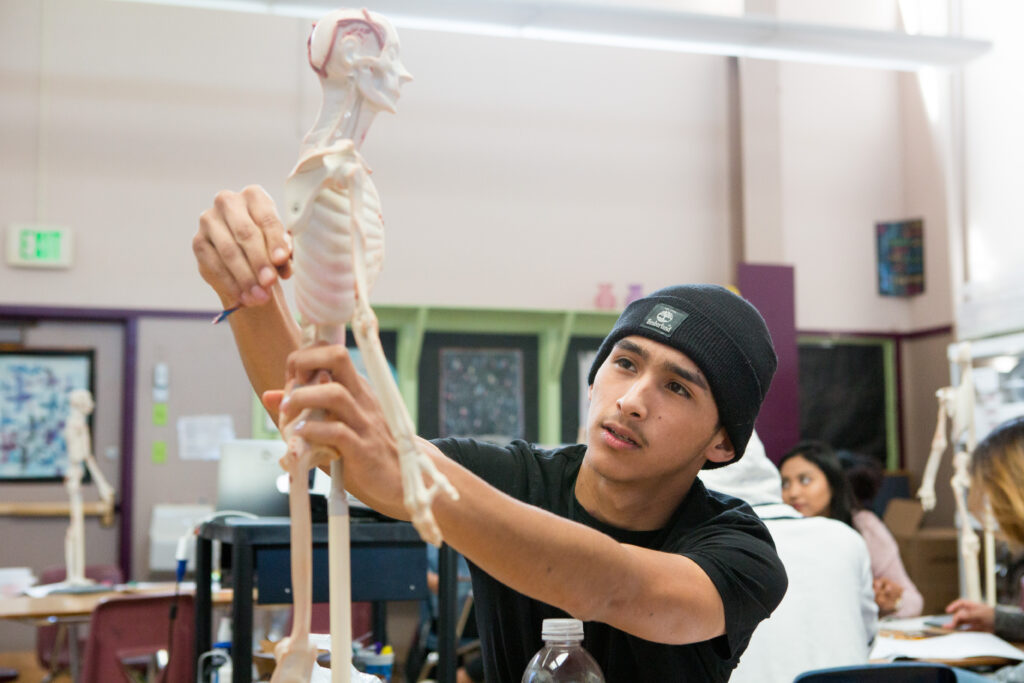
A student in Oakland’s Skyline High School Education and Community Health Pathway sculpts a clay model of the endocrine system.
Credit: Allison Shelley for American Education
It’s time to balance out our lopsided education system. Millions of parents and students have long struggled with our one-size-fits-all model, which primarily teaches to, tests for and celebrates students as theorists, not practitioners.
Our current system acts as a gatekeeper to the middle class by doling out opportunity based on grades and test scores in a traditional classroom setting, but rarely recognizes competencies and interests beyond standardized exams and essays.
Fifty years ago, students could opt into publicly funded trade schools and apprenticeships or enroll in practice-based classes like home economics and shop in traditional academic schools, which taught skills that led to well-paying jobs in carpentry, culinary arts and other trades. But over time, public funding for such programs dried up. The share of federal spending on vocational instruction as part of elementary and secondary education dropped from roughly 30% in 1970 to just 7.5% in 2022. Even as elementary and secondary education spending ballooned from $5.8 billion a year to $96 billion during this period, the vocational component grew only from $1.8 billion to $7.2 billion.
Most publicly funded instruction now happens at desks, with grading based on written exams, essays and problem sets rather than demonstrations and hands-on learning. Some students are more prepared than others to succeed in such a system, exacerbating existing inequalities.
Research by the Economic Policy Institute found that social class, as defined by parental income, education and job, is the leading predictor for a student’s school readiness: Kindergartners from the highest social class possess more theory-based skills and perform an entire standard deviation higher on math and reading tests than kindergartners from the lowest social class. The gaps are particularly high for Black and Hispanic students, who are more likely than white children to live in poverty. When some students inevitably falter, the system tells them they are failures and offers trade schools and technical colleges as second-tier alternatives they often must pay for themselves.
It didn’t have to be this way. The United States originally based its system on a German/Prussian model, which prioritized efficiency by tracking students into “academic” or “vocational” tracks at age 10. In that model, still in place in Germany today, students are expected to know what they want to do by adolescence, and many simply end up in the same track as their parents.
The United States, hoping to advance a true meritocracy, did not want a system that limited intergenerational mobility in this way, and over the 20th century we adopted a liberal arts approach that was supposed to prioritize economic and social mobility. But in a myopic attempt to get rid of tracking, we inadvertently eliminated vocational education and simply tracked all our students into the academic model. The result? The worst of both worlds for less traditional students who struggle in a sink-or-swim academic system.
Student outcomes now depend a lot on parents’ backgrounds, just like in Germany.
There is another possibility. Consider Finland, which in the 1970s switched from the German model to one that teaches a combination of academic and technical subjects until age 16, when students choose a track. The vocational path for students interested in highly -skilled trades includes carpentry and culinary arts, but it also offers applied sciences, health care, and social services, which in the United States would require attending traditional academic universities.
Finland’s vocational path is highly competitive and includes matriculation at rigorous polytechnic universities with high-level training in subjects like business, engineering and nursing and quality instructors with connections to actual companies — not an alternative education. With a system that celebrates the value of highly skilled thinkers and workers, Finland recently ranked first out of 143 countries on the World Happiness Report for the seventh consecutive year, and as of 2021, its income inequality is eighth lowest among 37 countries in the Organization for Economic Cooperation and Development (the United States ranks 23 on the World Happiness Report, and its income inequality is down at 33, beating only Turkey, Mexico, Chile and Costa Rica).
Of course, the United States is not Finland, and we cannot simply adopt its system. (Though before you discount Finland because of its smaller or more homogeneous population, consider that its size and composition are comparable to many U.S. states, and much of U.S. education policy is decided at the state level.) What we can do is stop deciding who is educated, intelligent and successful based on only one type of student. Instead, we should recognize the value of all students, and offer more mainstream career and technical opportunities across K-12 education.
States and the federal government should fund more career and technical education, including apprenticeships, hands-on learning courses and training and recruitment for vocational teachers. They should work with employers, schools, training organizations and other groups to tie education to the workforce needs of their region.
Everyone should be given the opportunity to pursue a traditional academic education, but they should also be able to pursue an equally rigorous vocational one, equipped with public resources and support. Only then will the middle class truly be open to all.
•••
Eric Chung is a lawyer, a Paul and Daisy Soros Fellow, and a Public Voices Fellow of the OpEd Project. His work focuses on law and policy related to economic mobility and educational opportunity.
The opinions expressed in this commentary represent those of the author. EdSource welcomes commentaries representing diverse points of view. If you would like to submit a commentary, please review our guidelines and contact us.

